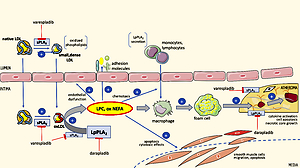Current issue
Archive
Manuscripts accepted
About the Journal
Editorial office
Editorial board
Section Editors
Abstracting and indexing
Subscription
Contact
Ethical standards and procedures
Most read articles
Instructions for authors
Article Processing Charge (APC)
Regulations of paying article processing charge (APC)
CARDIOLOGY / STATE OF THE ART PAPER
On the present and future role of Lp-PLA2 in atherosclerosis-related cardiovascular risk prediction and management
1
Centre for Preventive Cardiology, Department of Vascular Medicine, Division of Medicine, University Medical Centre Ljubljana, Ljubljana, Slovenia
2
Chair of Internal Medicine, Medical Faculty, University of Ljubljana, Ljubljana, Slovenia
3
Medical Faculty, University of Ljubljana, Ljubljana, Slovenia
4
Department of Hypertension, Medical University of Lodz, Poland
5
Polish Mother’s Memorial Hospital Research Institute, Lodz, Poland
Submission date: 2020-01-10
Acceptance date: 2020-01-12
Online publication date: 2020-08-20
Publication date: 2021-07-16
Arch Med Sci 2021;17(4):954-964
KEYWORDS
atherogenesisphospholipasesbiomarkersecretoryphospholipases A2lipoprotein-associated phospholipase A2(Lp-PLA2prognosisanti-inflammatory agents
TOPICS
ABSTRACT
Circulating concentration and activity of secretory phospholipase A2 (sPLA2) and lipoprotein-associated phospholipase A2 (Lp-PLA2) have been proven as biomarkers of increased risk of atherosclerosis-related cardiovascular disease (ASCVD). Lp-PLA2 might be part of the atherosclerotic process and may contribute to plaque destabilisation through inflammatory activity within atherosclerotic lesions. However, all attempts to translate the inhibition of phospholipase into clinically beneficial ASCVD risk reduction, including in randomised studies, by either non-specific inhibition of sPLA2 (by varespladib) or specific Lp-PLA2 inhibition by darapladib, unexpectedly failed. This gives us a strong imperative to continue research aimed at a better understanding of how Lp-PLA2 and sPLA2 regulate vascular inflammation and atherosclerotic plaque development. From the clinical viewpoint there is a need to establish and validate the existing and emerging novel anti-inflammatory therapeutic strategies to fight against ASCVD development, by using potentially better animal models and differently designed clinical trials in humans.
Share
RELATED ARTICLE
We process personal data collected when visiting the website. The function of obtaining information about users and their behavior is carried out by voluntarily entered information in forms and saving cookies in end devices. Data, including cookies, are used to provide services, improve the user experience and to analyze the traffic in accordance with the Privacy policy. Data are also collected and processed by Google Analytics tool (more).
You can change cookies settings in your browser. Restricted use of cookies in the browser configuration may affect some functionalities of the website.
You can change cookies settings in your browser. Restricted use of cookies in the browser configuration may affect some functionalities of the website.



